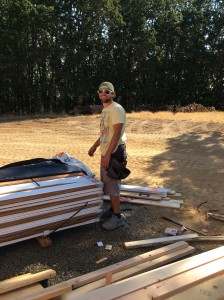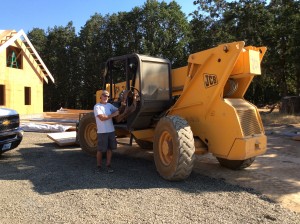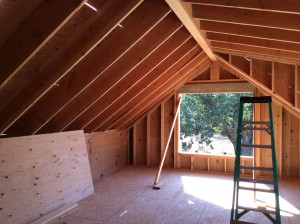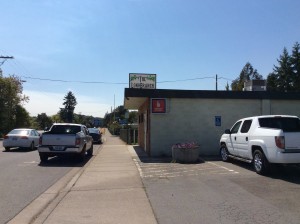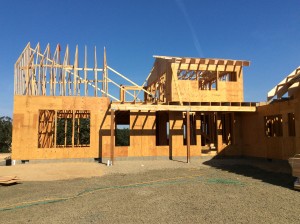“Been a year now,” I say. “When exactly did we sign the papers?”
“More than a year,” Larry says. “Thirteen months. We signed on July 10, ’14.”
Time to see how we’re doing, then. We went to the H.A.Woods Saturday morning with the intent to start work on the weedy mess that occupies the vacancy where the old house once stood. A couple of big-leaf maples that are being strangled by the loving embrace of English ivy. Tangles of blackberry, thistle, an undergrowth of vinca, and a wealth of smashed cans, an old colander, plastic bags.
So, we can count the demolition of the house as one accomplishment for the year, plus the driveway and the new house that’s rising up on the hill. Is that a lot for one year?
Okay, then let’s add the contract we signed with USF&W and the Conservation Plan drawn up with Steve Smith. Which were made possible by walk-about visits we made to the neighboring conservation sites along the Muddy Creek corridor, as well as walk-abouts on our own property with Steve, locating native plants, counting birds.
Our little orchard is thriving, neatly fenced in from elk and deer, none of which have we seen in person, by the way, if “in person” can apply to large, horn-bearing mammals.
The large, dangerous oak in the back yard has been tamed, distorted, and while this was necessary, I suppose, I don’t think of this as an accomplishment. Something we had to do, and did.
The cows. Wouldn’t call that a success, as they’ve severely overgrazed the savanna. The wetland doesn’t seem to have suffered as much, nor the oak forest or creek banks. But the good news is that Mark Wahl, Cow-Guy, has agreed to the concept of rotational grazing next year in return for a waiver of the leasing fee.
But we completely lost the war with the tansy, thistle, and blackberry. Giving up, we have an agreement with a sprayer to do the berries this September. A hundred dollars an hour. Whew. So he’ll go until we say stop. We don’t know if he’ll spray, then come back and grind the stalks after the roots have swallowed the poison, or grind as he goes. One of the many, many things we have to learn. Too late for tansy and thistle, but he’ll spray next spring or early summer when appropriate.
A snapshot: Saturday morning. We drive to the barn, where Larry straps himself into the weed-whacker harness, and turns on the machine. Nope. The filament is down to a stub, and the machine won’t release additional strand as it is meant to do. Sigh. This requires a half-hour of disassembly, a certain amount of swearing, as things don’t go back properly, and then, success. But no, as he begins to work, the machine fails again. More mechanical tinkering, and it becomes clear that a farmer needs to be a mechanical engineer as much as anything else. But finally, it all works, and our Larry works for a couple of hours clearing the undergrowth.
Meanwhile, I’ve been picking blackberries using a new system I’ve devised for taming the murderous thorns, and have several quarts cooling under ice in the car.
We quit for lunch, and head for the Longbranch Bar and Grill in Monroe, discovered last Wednesday after golf with friend Dinah at Diamond Woods. Great atmosphere, good food. We discuss whether we’ll return for another round of clearing at the farm, but choose instead to have a look at a John Deere tractor out on the edge of the road to the golf course.
It’s pretty cool. Just the right size, a 2008 model, but we can’t tell if it’s diesel. Larry kicks the tires, metaphorically, and says he’ll call later, after perusing the pamphlets he’s been acquiring from the John Deere dealer back at home. But my sense is that he doesn’t want to jump into tractor ownership until it’s clear that he really needs one. Don’t want to have a shiny green machine sitting in the barn, gathering mouse poop and cobwebs. I agree. We’ll see. We absolutely will need a mower of some size, and a rider, such as we had in Tigard, would be wildly inadequate. Seriously, Larry is a good, intuitive mechanic, but is what he knows enough?
I’m disappointed in myself,” Larry says on the way home that afternoon. “I should be able to work longer than two hours, and I’m just exhausted.”
I’m disappointed in myself, too. I haven’t written much about my brilliant musical career, but it is part of our decision about how much time we imagine we’ll spend on the farm versus here in PDX. Right now, I have to wait until Monday morning to see if I’m still on the mailing list for the next practice of the Spotted Cats. I know my own inadequacy, but would like the chance to improve. Can’t really ask that if the band suffers from its lame, struggling banjo player.
The answer, of course, is to accept the limitations of age and competence. That was the promise when we launched the big farm adventure. Each day to have fun, meet the challenges as we can. Don’t give up. Of course we get tired, and of course we stumble over the electric fence and fall into ditches and weed whack a tree to death.
I set out to write a “Year in Provence” kind of account with the hope that I can whip the pages into some form and begin the masochistic process of trying to publish it. Now the year has passed, and my mission with this blog will change. Larry is probably quite relieved that I won’t be “sharing” our pratfalls and mistakes. Oh. Well, maybe I will. Sorry, Larry.

